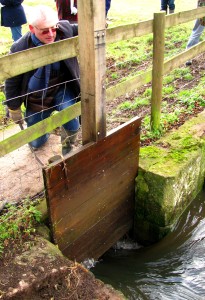Dr M looked out of his window and notices – it’s raining again!
Roger Brugge of the Meteorology Department at University of Reading, puts the recent rains in context:
“after a dry start to December 2013, a total of 165.3 mm (roughly 6.5 inches) of rain was recorded in the 28 days ending on 8 January 2014.”
Roger Brugge continues:
“This total represents just under three times the rainfall we would normally expect in such a period at this time of year – or a little over a quarter of all the rainfall we would expect to receive in a year, in just 4 weeks!”
OK its official: it’s rained a lot this Winter!
Some experts tell us we must get used to increasingly wet winters as part of the medium-term rearrangement of our weather patterns due to climate change. Check out the climate projections here.
So much water really changes the landscape, creating extraordinary vistas of overflowing rivers, streams and ditches and water filled fields, meadows, woodlands and homes.
What does this mean for the plants growing on flood plains, like grasses, and herbs and also arable crops?
These plants are not normally aquatic but, by living and growing, and just being, on flood plains, they find themselves seasonally flooded.
In his occasional series of guest posts Dr M’s long-time colleague and hydrologist extraordinaire Dr Hadrian Cook explains what so much water means for plants and the landscape.
Dr Hadrian Cook writes:
 “Periods of natural flooding inevitably bring the media to report on urban land uses, particularly development of housing within floodplains or other flood- prone areas. This is understandable, because it is traumatic, to say the least, to have your house invaded at best by unwelcome water, or at worse by sewage.”
“Periods of natural flooding inevitably bring the media to report on urban land uses, particularly development of housing within floodplains or other flood- prone areas. This is understandable, because it is traumatic, to say the least, to have your house invaded at best by unwelcome water, or at worse by sewage.”
“What is not so often pointed out is how agriculture has impacted on floodplains with a phenomenal loss of habitats and associated botanical diversity. Due to the economics of farming, it is considerably more profitable to use floodplain land for arable crops such as winter wheat, than for grazing cattle or sheep. I have seen statistics that show that a farmer can make more profit from arable agriculture, even if with periodic flooding resulting in loss of yield or crop, than for investing in floodplain grazing.”
“Historically, floodplain land uses have involved grazing by sheep or cattle. Floodmeadows, grazing marshes and even the complex ‘floated’ watermeadows of Wessex and elsewhere support grass swards that are resilient to inundation, even a degree of salinity near to coasts. Livestock, on the other hand, can simply move if conditions are adverse. Indeed, many grasses including Agrostis stolonifera are components of wetlands and floodplains support certain rare grass sward communities, such as Cynosurus cristatus –Caltha palustris (MG8) grasslands are rare communities of alluvial soils on river floodplains. Reedbeds even require submersion under water. These vegetation communities, alongside wet woodlands and a range of native wetland types, are tolerant of submersion, something that most agricultural crops are not.”
“Arable agriculture remains profitable in a time that may be signalling better economic conditions for British farmers, with rising world food prices. Arable cropping on floodplains is problematic, not only because of habitat loss, but also due to the potential of loading agro-chemicals and sediment into the river channel itself. We should never lose sight of the heritage, ecological and sustainability value of semi-natural value of our floodplain ecosystems. There should remain, and indeed be enhanced, agri-environmental scheme protection for floodplain areas such as Higher Level Stewardship that gives farmers and others the incentive to manage the vegetation of our floodplains and wetlands in a sustainable manner.”
Further reading:
Cook, H.F. and Williamson, T. (eds) (1999). Water Management in the English Landscape: Field, Marsh and Meadow, Edinburgh University Press, 274 pp.
Image of Dr Hadrian Cook drowning the floodmeadows at Harnham, Salisbury courtesy of the Harnham Water Meadows Trust.
Want more hydrology? Check out Dr M’s video of the River Loddon near Reading in January 2014, showing exactly what flood plains do and what they are for!
The featured image at the top of this post shows the River Loddon near Reading (left hand image) and an adjacent tributary (right hand image) overflowing every which way on 7th January 2014. The video shows all the wondrous watery details!

